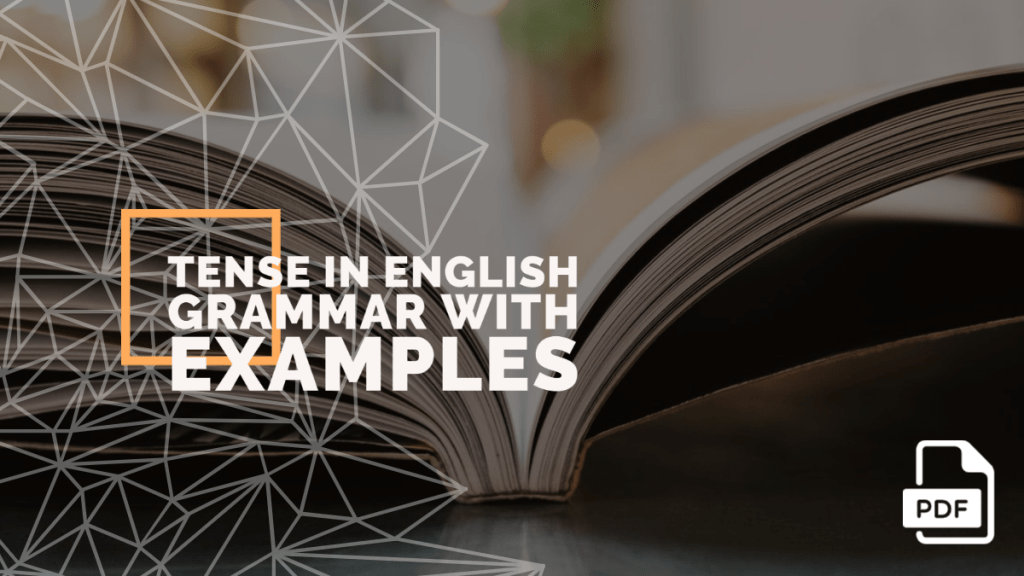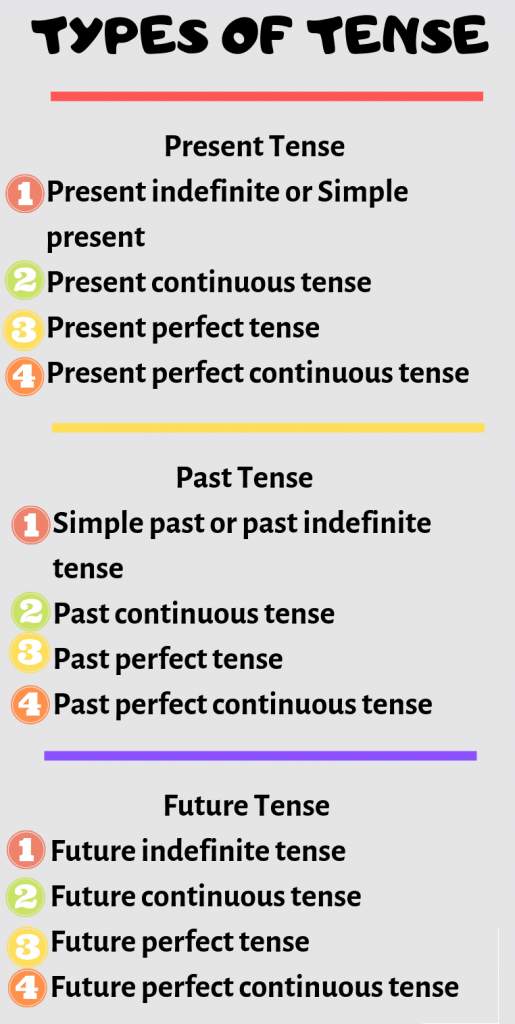Tense in English Grammar with Examples [PDF]
In this lesson of English Grammar, we are going to learn What is Tense in English grammar, and we also see the different types of tenses with suitable examples. To download the PDF of this lesson please find the PDF downloadable link mentioned below of this article.

What is Tense?
It is defined as the form of a verb which indicates the time and the state of an action or event.
How many types of tenses are there?
There are three major types of tense:
- Present Tense
- Present indefinite or Simple present
- Present continuous tense
- Present perfect tense
- Present perfect continuous tense
- Past Tense
- Simple past or past indefinite tense
- Past continuous tense
- Past perfect tense
- Past perfect continuous tense
- Future Tense
- Future indefinite tense
- Future continuous tense
- Future perfect tense
- Future perfect continuous tense
Let I show you in details the types of Tenses.
NOTE:
- V1= BASE FORM OF VERB
- V2= PAST SIMPLE
- V3= PAST PARTICIPLE

Present Tense:
What is Simple Present or Present Indefinite tense?
It denotes habitual action, custom, practice, repeated action, permanent/eternal, general truth etc.
Simple present or Present indefinite tense structure:
- (SUBJECT + V1 + OBJECT)
For examples,
- The boy goes for a walk in the morning.
Ayesha always comes in time. - The cow gives milk.
- The sun rises in the East.
We use simple present or present indefinite tense when:
Historical present:
For example,
- Babur now leads his man through the Khyber Pass.
- Now Arjuna shoots arrows at Bhishma.
Future arrangement:
Near future without pre-planning.
For example,
- He leaves Tokyo tonight.
- He comes in a few days’ time.
- The school opens at 8 a.m. after the vacation.
- He comes back from London tomorrow.
Habitual action or recurring action:
For examples,
- He takes exercise every day.
- Ram goes to school
Universal Truth:
For example,
- The earth moves around the sun.
- Truth is power.
Facts of the present:
For example,
- He is a good girl.
- There is a temple.
Keywords:
Every day, usually, generally, normally, sometimes, every week, every year, etc.
When these words are present in a sentence and also follow the present indefinite sentence structure, you can easily identify that the tense of the sentence is simple present
What is Present Continuous tense?
It refers to an action in progress in the present at the time of speaking.
Present continuous tense sentence structure:
(SUBJECT + AM/ IS/ ARE + MAIN VERB + ING)
For examples,
- He is playing chess.
- It is raining now.
It also expresses future action or a definite arrangement in the near future.
For examples,
- She is going to write a book
- I am going to my father tomorrow
The following verbs for their meaning are not generally used in continuous form (present, past, future):
- Verbs of perception:
Hear, see, smell, taste, etc.
- Verbs of emotion or state of mind:
Love, hate, wish, Desire, hope, want, etc.
- Verbs of appearance:
Appear, look, seem, etc.
- Verbs denoting possession:
Own, have, belong, comprise, possess, etc
For examples,
- She is owning a car. (wrong )
– She owns a car (right) - I am having no house. (wrong)
– I have no house. (right)
- A continuous action of the present moment:
Keywords:
Now, still, at present, etc.
For example,
- He is studying now.
- Static verbs cannot be used in progressive action:
For example,
- The glass contains water.
- He owns a house.
- The flower smells sweet.
- I see he is a good boy.
- The temple stands in the heart of the city.
- Near future + planned action:
For example,
- I am leaving for Dubai tonight.
- We are going on a trip to Rajasthan this month.
NOTE: Do not use Present Continuous tense when the action is OFFICIAL.
What is Present Perfect tense?
The action is over but the result or effect is still continuing.
Present Perfect tense sentence structure:
(SUBJECT + HAS/HAVE + V3 + OBJECT)
Keywords:
Just, just now, yet, of late, lately, recently, already, etc.
For example,
- I have just finished the walk.
- She has already had her breakfast.
- I have come to know about it lately (Adverb).
- Of late (Prepositional Phrase), the number of literates increased.
What is Present Perfect Continuous tense?
A continuous action running for a certain period of time.
For example,
- I have been reading this book since morning.
- I have been reading this novel for seven hours.
We use since for staring time of the action.
And for, a total duration of the action.
Present Perfect Continuous tense structure:
(SUBJECT + HAVE/HAS + BEEN + V1 + ING + OBJECT)
NOTE:
- ‘Since’ is used only in present perfect continuous. It cannot use in Past or Future tenses, there we can use ‘From‘ in place of ‘Since‘
- If any static verb [External Link] is used in the structure of the present perfect continuous tense, the verb form changes into present perfect tense
For example,
- He has been owing this house since 2005 (Wrong)
- He has owned this house since 2005 (Right)
Past Tense:
What is Simple Past tense or Past Indefinite?
Simple past tense is used to convey that the action is completely over or an indefinite action of the past.
Simple past or Past indefinite tense structure:
(SUBJECT + V2 + OBJECT)
- Negative [External Link]:
(SUBJECT + DID NOT + V1 + OBJECT )
- They did not go.
- Interrogative [External Link]:
(DID + SUBJECT + V1)
- Did he arrive?
- Interrogative negative:
(DID NOT + SUBJECT (NOUN) + V1)
(DID + SUBJECT (PRONOUN)+ NOT + V1)
- Did not the boy play?
- Did he not play?
Keywords:
Yesterday, ago, before, back, last night, last year, year/date/day of past, etc.
Past Habit:
For example,
- I used to take exercise every morning.
- I met the boy yesterday.
- He went away five minutes ago.
- I passed in an examination in 2016
Recent or the distant past:
For example,
- Her father died yesterday.
- Babur founded the Mughal Empire in India
Point of time:
For example,
- People lived in caves a long time ago.
What is Past Continuous tense?
A continuous action of the past moment.
For example,
- He was studying when I saw him.
Past continuous tense structure:
(SUBJECT + WAS/WERE + V1 + ING + OBJECT)
- I was reading.
- They were reading.
Keywords:
Then, that time, when (Conjunction) + past tense, a particular time of the past.
For example,
- I was studying at 6 am yesterday.
- He came while I was studying.
- I was studying when he came.
- Rain stopped when he came (Simple past).
NOTE:
- Always use ‘While‘ before Past continuous tense. Don’t use ‘when’.
What is Past Perfect tense?
It expresses an action which was completed before another past action.
Past perfect tense structure:
(SUBJECT + HAD + V3 + OBJECT)
In the case of two successive actions of the past, past perfect tense is used with the first action.
For example,
- The patient had died before the doctor arrived.
- The patient died after the doctor had examined him.
What is Past Perfect continuous tense?
A continuous action that was running for a period of time in the past.
For example,
- He had been suffering from fever before he came here.
Past perfect continuous tense structure:
(SUBJECT + HAD + BEEN + V1 + ING + OBJECT + TIME FRAME)
- I had been working with the company for 5 years.
- I had been working with the company from 2011-2016
Use,
- For – Total duration of action.
- From – The starting point of action.
- To – Ending point of action.
Future Tense:
What is Future Indefinite tense?
It expresses an action that will happen in the future.
Future indefinite tense structure:
(SUBJECT + WILL / SHALL + V1 + OBJECT)
For example,
- I shall visit your place.
- He will write a letter.
- You will make it.
Keywords:
Soon, shortly, in a few moments, tomorrow, next week/ Month/ year, etc.
For example,
- She will reach here shortly.
- They will arrive soon.
Generally, ‘shall’ is used with the first person of pronoun, ‘I’ ‘we’ ‘will’ is used with second and third persons. besides, ‘shall’ and ‘will’ can be used reversely.
For example,
- You shall not move. (order)
- I will stand by you. (promise)
- They shall be rewarded. (assurance)
Sometimes, future action is expressed in the present continuous tense.
For example,
- She is getting engaged soon. (certain to marry)
Future action is also expressed in the present indefinite tense.
For example,
- The pm leaves for Mumbai next Sunday.
- She arrives from London next month.
What is Future Continuous tense?
It is used to express an action which will be in progress at a given time in the future.
Future Continuous tense structure:
(SUBJECT + SHALL / WILL BE + [V + ING] )
For example,
- She will be writing to me when I reach home.
- I shall be sleeping at 11 o’clock at night.
What is Future Perfect tense?
It is used to express an action which will be in progress at a given time in the future.
Future Perfect tense structure:
(SUBJECT + SHALL/WILL + HAVE + V3)
For example,
- He will have typed 8 letters by lunch today.
- I shall have known her for five years next month.
What is Future Perfect Continuous tense?
It is used to express an action which will begin before a definite moment in the future and will continue up to that moment and will be in progress even at that moment.
Future continuous tense structure:
(SUBJECT + SHALL/WILL + HAVE + BEEN + V + ING)
For example,
- When the clock strikes eleven, I shall have been writing these letters for three hours.
- The poor will have been starving for many days.
A Must Watch Video Lesson on Tense:
So that’s all for tenses in English Grammar. I recommended you to check out our parts of speech related topics too. It will definitely help you a lot.
References [External Links]:
- Future Tense | What Is the Future Tense? – Grammar Monster
- Present tense | LearnEnglish – British Council
- The past tense (video) | The tenses | Khan Academy